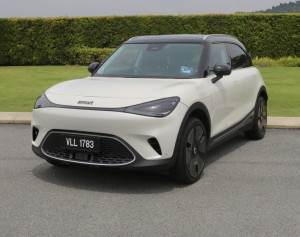The front trunk is electric cars’ most divisive feature
By BLOOMBERG | 01 November 2022
NEW YORK: Nothing screams "future of transportation” like an 80-mile-per-hour sushi bar.
At least that’s how Ford is marketing the refrigerator-sized front trunk that comes standard on two of its electric vehicles, complete with drain.
Seafood not your thing? Ford suggests loading it up with 1,000 chicken wings.
It’s still early days in the race for EV supremacy, and while engineers have rushed to improve driving ranges and charging speeds, they remain split on the front trunk.
Roughly one-third of the 30 or so EV models for sale in the US have supersized the feature in recognition of its novelty and utility - after all, a "frunk” is one of few things EVs offer that a gas-powered vehicle cannot.
Another third of models, however, skip the frunk altogether, freeing up cabin space on a bet that customers accustomed to frunkless living won’t demand one when they go electric.
Frunks aren’t new to the auto industry. Models with engines in the rear of the car, like Porsche’s 911 and the defunct Chevrolet Corvair, have long offered a front trunk in lieu of a rear one.
But for the first time, EVs are allowing drivers to get the best of both - and automakers are reacting accordingly.
Ford’s plug-in pickup, the F-150 Lightning, boasts the biggest frunk space on offer, but even some smaller, sportier EVs are designed to carry large cargo where an engine would have been.
The Lucid Air has a 7.1-cubic-foot cavity up front, roughly the size of a freezer chest, while Tesla’s Model Y stretches the tape to 4.1 cubic feet, a fair-sized wine fridge.
As such, the frunk has become the identifying calling card for a new species of vehicle that doesn’t overtly display its novelty.
No one can see the massive battery or the electric motors under the skin of an EV, but a cavernous frunk is hard to miss. With a ceaseless stream of social media content, the feature is proving to be the best kind of marketing engine: one that runs on its own.
There’s the standard frunk flex: ice and beer. Then the bolder: durian fruit, for example, or pumpkins. The seasonal: heaps of candy behind giant teeth.
And the awestruck: Frunk owners seem compelled to close themselves in the compartment at least once, as giddy as toddlers in a sandbox. There’s even a #frunkpuppy Instagram trend, which is exactly what you might expect.
And yet frunk-free EVs are also common. Neither of BMW’s new electric sleds - the iX SUV and the i4 sedan - has a frunk.
Nor does the EQS sedan from Mercedes, which won’t even let customers pop the hood on its EVs without a deep YouTube search and some ill-advised tinkering.
Mercedes engineers went so far as to design a little panel that flips out of the side for drivers to replenish windshield-wiper fluid.
"In our view, the boot in the rear is more than large enough,” Cathleen Decker, a spokeswoman, said.
"The feedback we receive is very positive.”
Nissan’s LEAF, one of the oldest and best-selling EVs to date, never had a frunk, because it was designed using a traditional, gas-powered car as its base. But Nissan’s Ariya SUV, which will start shipping to dealers later this year, doesn’t have one either. Nor does Toyota’s bZ4X, an electric vehicle designed from scratch.
The rationale for frunk-free automakers is that filling the front of the car with gear and gadgetry makes for a more spacious cockpit. Mercedes, for example, has an air-filtration system where a frunk might have been.
Toyota’s bZ4X has its HVAC system and 12-volt battery up front, creating a cabin about as spacious as its Rav4, a far bigger car.
"All of these components have to be placed somewhere,” said Tom Kretschmann, Toyota’s senior technology education planner. "And by putting them up front, you’re not really changing that SUV expectation.”
Bozi Tatarevic, a race-car mechanic and auto journalist, prefers an EV without a frunk.
"I’m a tall person and you basically get more leg area and foot room,” he said. "And as a mechanic, I would much rather pop open the hood and have easier access to whatever I have to service.”
Meanwhile, Denver-based Erin Persaud calls the frunk on her Kia EV6, which is about the size of a 12-pack, something of a disappointment.
"Honestly, we haven’t used it,” she said. "My kids plan to put snacks in there.”
Not all EV fans are as diplomatic. Both BMW and Mercedes have been criticised for not fully embracing the frunk. Jon Rettinger, host of an eponymous YouTube channel reviewing cars and other technology, ordered a Mercedes EQS a few months ago.
When the deal went sour because of a dealership mark-up, he bought a Rivian pickup, in part because of the cargo space it offered up front.
"If I’m looking at an electric car that doesn’t have a front trunk, perhaps wrongly, I’m thinking there was a problem in engineering,” Rettinger said.
"Or it’s built on a platform that wasn’t designed to be fully electric.” The argument that most consumers don’t want or need one feels condescending to him - "like a pat on the head.”
Jason Fenske, who produces the YouTube series Engineering Explained, said the lack of a frunk is the most frustrating thing about BMW’s i4, primarily because there’s a cavity under the hood that is large enough to hold a rolling suitcase.
Indeed, the Internet is full of DIY hackers explaining how to finagle a frunk unofficially.
Kia’s Niro and Hyundai’s Kona EV, for example, are born frunkless, but some industrious buyers hacked together a solution using 3D-printed mounts and a rubber bin.
In the EV ecosystem, nature finds a way.
So what is the future of frunks? Laycee Schmidtke, an industry consultant who also reviews vehicles on the YouTube platform Miss GoElectric, thinks frunk-free EVs will fade in a few years as car executives start sourcing smaller components.
"Legacy automakers often have supplier agreements or existing economies of scale which can be strong motivators for them to squeeze less than optimal hardware into their EV platforms,” she said.
"As more automakers develop EV-exclusive platforms, I can see a future in which frunks are standard fare.”
For now, the safest space in the front-trunk debate appears to be the middle ground. About one-third of the EVs on the US market at the moment offer relatively tiny frunks - around 56 litres or less. That’s big enough to check the "frunk” box among prospective buyers, but just barely.
Tags
Autos News
Reviews

Guangzhou adventures: Zontes 368 scooter and 703 Adventure m...

Zontes motorcycle factory in Jiangmen: Running on a fast tra...

7.6
Maserati GranTurismo (Mk2) Modena: Sharp and smooth operator

6.8
Triumph Tiger 900 GT Pro: Multi-talented adventurer

Hyundai Ioniq 5 N: Born rascal

6.6
Husqvarna Svartpilen 401: Inspiring retro design

8.8
smart #1 (Premium): Agile, engaging, roomy, premium motoring

6.6
Suzuki V-Strom 250 SX: Multi terrain warrior
Videos

StarCarSifu Editors' Choice Awards 2024: Top winners

The Snowball – Lamborghini’s Heartwarming Christmas Story of...

EVOGO battery swapping solution showcased at IAA Mobility 20...
